
I did Coventry to Land's End on a Trek hybrid that I'd for a 'few' years (nine I think). It did the job. The only additions for the trip were a new saddle and a front rack. It was never what I would describe as comfortable; I had pins and needles in my hands fairly frequently and when I finished I could hardly move (although it is perhaps unfair to blame the bike for that). En route I required new rear brake blocks and a new crank (although that was a long-standing issue). When I limped home (or whatever the two wheeled equivalent is) I had one bar end pointing over my right shoulder and 3 available gears.
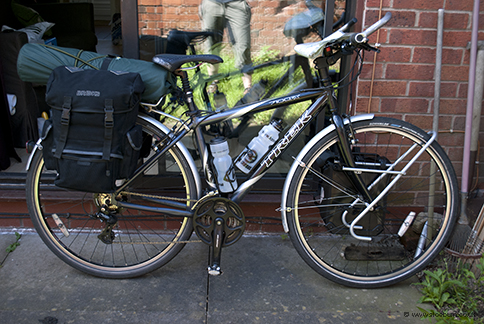
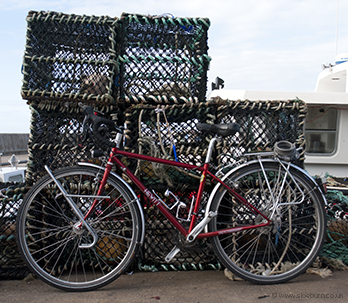
Clean!
For the John o'Groats trip I bought a nice new tourer, a Hewitt Cheviot. I had one trip to the shop in Leyland for a fitting and to sort out my order - you can specify anything you like but as I'd never had a drop bar bike before I went with the recommendations from Mr Hewitt. They do delivery but I'm glad I paid them another visit to pick it up, as it gave me a chance to tweak things. I've done more tweaking myself since then. The nice thing about having someone put a bike together is that you can use bits you already have - I didn't need a saddle or front or rear racks. After the first visit I looked into lighting and decided I might as well spend the extra £ at this stage and get a Schmidt hub dynamo. I also wanted a bit of customisation so I asked for a 'naked' frame and had some decals printed.
I went for a trial camping weekend in Oxfordshire, and as soon as I started pedalling fully loaded it felt just as though that was what it was made for. I dare say that someone used to a short wheel base carbon number would find it sluggish, but it's not that sort of beast. I've done a bit of saddle faffing, which included a Brookes which didn't work out, although I have since moved it to my Brompton where it is most welcome. For my JOG trip I moved the oldish comfy number that had been on the Brommie because I knew it would be ok, but it was dead by the end. I'm now back to the Selle Italia that I started with, but I've put a shorter stem on and it all seems to be working ok. I went for a Cyo front LED when I bought the bike, but I wasn't sure what to do for a rear light at that stage. I wanted to be able to remove the rear rack (for audax mode) so went for a mud-guard mounted LED. I fitted it myself, including the wiring, despite which it works. I haven't done an awful lot of night riding but I can already say that these lights are fantastisch. They are always attached to the bike, no battery worries, and they are nice and bright. I did quite a bit of reading beforehand, and there is no need to worry about drag from the dynamo - when you are riding around with fairly wide touring tyres, everything but the camping kitchen sink and are a stone overweight, there are a lot of other things slowing you down!
I took my usual bike tool and a Swiss army knife, a puncture repair kit, a spare inner tube, pump, and some Duck tape and cable ties.
When I bought my old hybrid I got a really solid rear rack and a discounted pair of Brookes panniers that were the last ones in the shop, which seemed keen to get rid of them. I've never quite worked out how they are supposed to be secured, but I've managed with three carabiners. They are totally bomb-proof and will, I suspect, last longer than my legs.
I got a new front rack and panniers for my LE trip; I went for the traditional waterproof Ortleibs which have been great so far. I definitely prefer having some weight up front rather than all at the back. I assume that it will rain horribly and pack accordingly - I have built up a collection of roll top dry bags which are great.
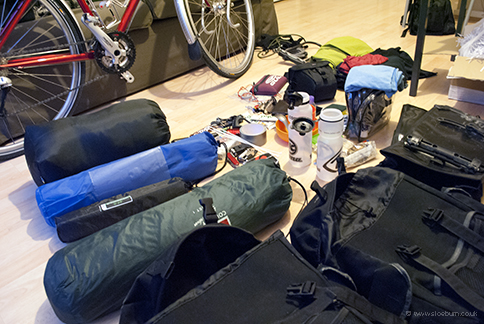
Terra Nova Aspect 1 - after a lot of research (which I thoroughly enjoyed) I found this, which I love. I was looking for a poles-outside outer-pitch-first tent. This one is high enough to sit up in (for a shortarse like me), and the door can be propped up to make a sort of porch, which makes a very good sheltered area for cooking as long as you are pitched with the door pointing out of the wind. It has never yet let any water in. I was a bit concerned about how well it would perform in strong wind and rain at the same time, but it's been fine with the extra guy ropes which brace the poles. Some creature in Brighton (a rabbit, or possibly a magpie) who was after my muesli has put a hole in the inner, but I have been too lazy to fix it.
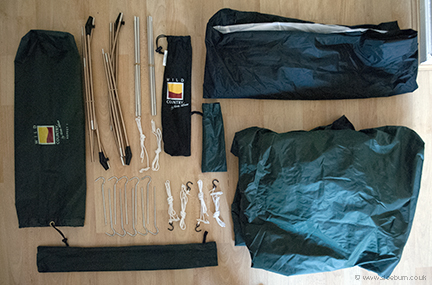
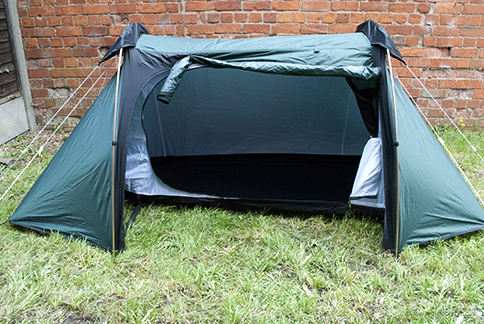
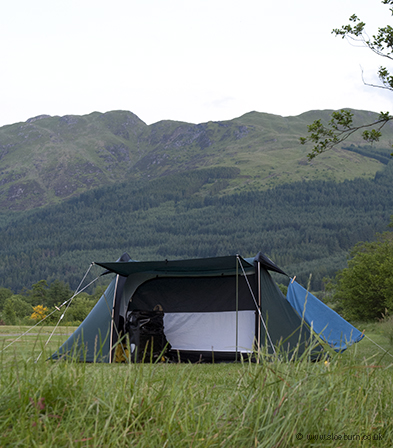
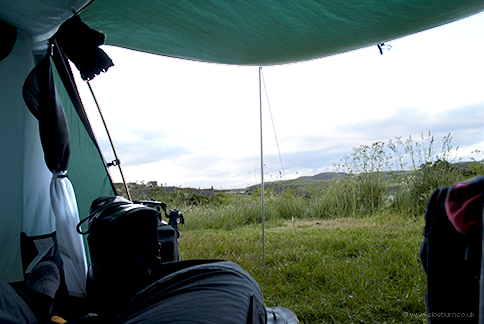
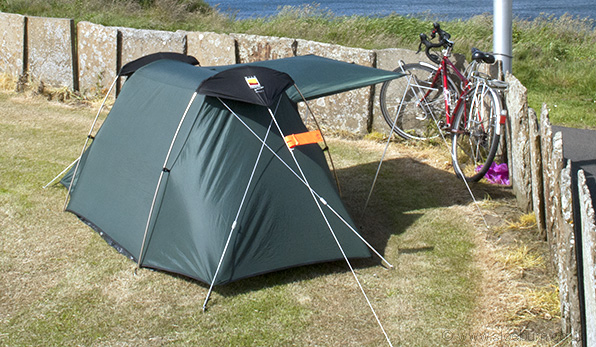
The tent in increasingly exotic locations: living room floor, back garden, Strathyre, Bettyhill, and Thurso.
When I bought a new one I was mainly concerned with temperature, but now I also think space is important too. It occupies most of a pannier, although I have managed to squeeze in some clothes next to it. This is something I would consider upgrading. I also made a sleeping bag liner out of an old sheet, which keeps the bag a bit cleaner and either adds a bit of warmth or can be used on its own when hot.
MatAfter reading about the crapness of modern tent inner groundsheets I came up with the cunning plan of putting my ancient foam camping mat underneath the groundsheet as a sleeping mat plus groundsheet protector in one. It was not comfortable. For the second trip I got a cheap self-inflating 3/4-length mat plus a 6" x 4" groundsheet - this was so much warmer and more comfortable that it was possible to have a lie-in. Since it meant that I was warmer at night I didn't need so many warm clothes, so overall isn't heavier or more bulky.
I spent quite a long time on route planning, having a good look around the web and making use of CTC's resources. The hard bit was working out how to get out of the Midlands and on to the more well-pedalled end-to-end routes. The further north I got, the easier, with the exception of the Glasgow area. I found a way through myself, but if I was doing this again I would do it differently.
I planned on covering around 50 miles a day, and then found campsites to fit in with this. I've been quite surprised at how few campsite there are in the UK, and I'd definitely recommend checking that any on maps or from old guidebooks are still open. It's more problematic in built-up areas where wild camping is not very practical. One thing I have found though, is that when walking or cycling you are unlikely to be turned away.
I didn't want to rely on anything electronic and I am quite a map fan anyway. I bought a Philip's 'Navigator' Britain road atlas for £20, which is spiral bound and has most of the UK at 1:100,000, dropping to 1:200,000 north of central Scotland. I removed the pages I needed, cut them in half (the pages are quite big) and laminated them. Then I marked the route on with a fine waterproof marker. The pages were held on to my handle bar with a Rixen Kaul map holder which I am fairly happy with, but it does need several sheets in to be thick enough to hold them tight. The lamination held up very well apart from a couple of pages which were driven over by a car - I think a re-lamination is all that is required.
Breakfast was either muesli with milk powder and water, or (as I got more lazy in the washing-up department) a Trek bar, which are fairly substantial. I tried to eat little and often, every 15 miles or so. I went through a lot of oatcakes, and eccles cakes were easy to find in certain parts of the country. Cakes and coffee were very welcome and I made a point of visiting independent cafes which became something to look forward to. Dinner was about half eating out and half campsite cooking, depending on the proximity of the nearest pub. For mainly nostalgic reasons (Duke of Edinburgh trips) I bought a Trangia. Having established that hot drinks were either easy and minging or lots of faff and welcome I decided not to bother and just took a pan for one-pot food. I had a lot of brown rice and red lentils, flavoured with either a curry-ish spice mix or miso, although I realise not everyone will share my enthusiasm for this. I picked up a bit of fresh fruit or veg en route - the only time I have ever seen the point of small packs of pre-prepared mixed veg.
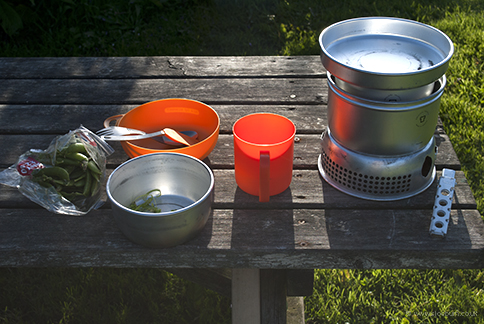
Dinner in Lizard. Not only did they have sun and picnic tables, but the campsite sold Old Rosie in what I am not sure are entirely legal plastic jugs (but please don't tell anyone).
I had two sets, one for daytime riding and one for evening post-shower. I am very fond of my merino t-shirt and 3/4 shorts for riding in. I also took a pair of cheap, light, zip-off trousers and a t-shirt, plus a merino mid-layer, a waterproof jacket and a buff. Riding in the summer means that being cold is not much of a problem. I used my waterproof to keep warm rather than dry - being wet in the winter is much more difficult. I had four pairs of pants and two pairs of socks, which were the only things I washed. One of my favourite cycling stories is of the chap who toured with 3 socks - one right foot, one left foot and one to wash, rotated each day. Drying things is the problem. I didn't use cycling shorts as I thought they'd take longer to dry, and also I only have one pair which I like and am tight. I rode in a pair of mountain bike style SPD shoes and took a pair of flip-flops for campsite wear.
Clothes pegs
Ear plugs
Head torch
Yoga